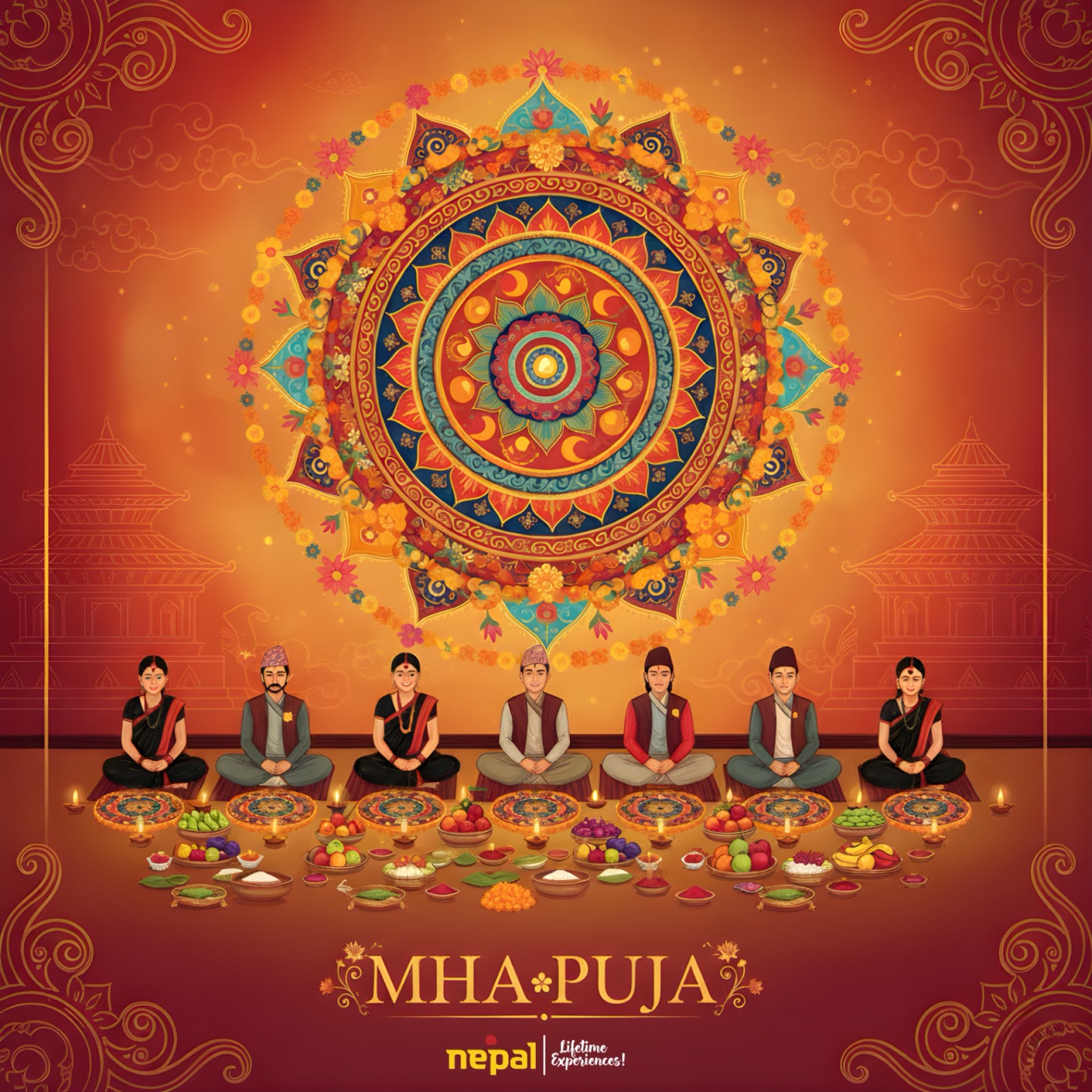-
Places to go
-
Things to do
-
Adventure
Nature
Culture
Wellness
Others
-
-
Festivals & Events
-
Festivals
Event Calendar
-
-
Plan Your Trip
-
Trip Ideas
Travel Details
Book Your Trip
-
- Travel Updates
Mha Puja: A Festival of Inner Light and Renewal

Among the many festivals that light up Nepal each year, Tihar—the festival of lights—holds a special place. For the Newar community, however, one of the most meaningful days during Tihar is Mha Puja, literally meaning “worship of the self.”
Observed on the fourth day of Tihar (Kartik Shukla Pratipada), Mha Puja coincides with the Newar New Year, celebrated according to the Nepal Sambat lunar calendar. On this day, Newars not only mark the beginning of a new year but also perform a profound ritual of self-respect, purification, and renewal.
Meaning and Significance
In the Newar language, “Mha” means self or body, and “Puja” means worship. Mha Puja is therefore a ceremony dedicated to honoring one’s inner self — the life force (atma) that sustains existence.
The ritual is rooted in the belief that divinity exists within each individual. By worshipping oneself, one acknowledges and purifies the inner spirit, inviting good fortune, health, and prosperity for the year ahead. It is both a spiritual and symbolic renewal, aligning with the Newar New Year’s themes of self-awareness and balance.
Preparations and Rituals
As dusk falls, families clean and decorate their homes. On the floor of the main room, they draw colorful mandalas (called mandap or sapu mandala) using colored powders, rice flour, and flower petals. One mandala is made for each family member, representing the universe and the individual’s connection to it.
Each mandala is decorated with oil wicks or small diyos (lamps), flowers, and offerings. In front of each mandala, a bajama (a ceremonial plate) holds ritual items such as beaten rice (chiura), fruits, flowers, and sacred threads.
The family gathers in a row facing their mandalas. The ritual begins with purification, followed by offerings of Tika, incense, and sagun—a set of auspicious foods traditionally including yogurt (dhau), egg, fish, meat, and rice wine (aila). These symbolize purity, creativity, strength, and good fortune.
The elders of the family—lead the ceremony, offering blessings for health, harmony, and prosperity in the coming year. The rituals vary slightly across households but maintain the same essence: reverence for life and the self.
Connection to the New Year
Mha Puja also marks the beginning of the Nepal Sambat New Year, a lunar calendar established in 880 AD by Shankhadhar Sakhwa, who is honored for clearing the debts of the people of Kathmandu.
Thus, Mha Puja is both a spiritual and cultural renewal — cleansing the self of negativity and welcoming the new year with clarity and optimism.
Symbolism and Philosophy
Beyond ritual, Mha Puja embodies a deeper philosophy: that the divine is not distant but resides within. The mandala represents the cosmos, and the lighted lamp symbolizes inner awareness and enlightenment.
By performing Mha Puja, individuals affirm the values of self-respect, mindfulness, and gratitude, recognizing that peace in the world begins with peace within oneself.
A Celebration of Light Within
As oil lamps illuminate homes and courtyards during Tihar, Mha Puja reminds the Newar people — and indeed everyone — that the truest light is the one we kindle within.
This unique tradition stands as a celebration of life, self-awareness, and spiritual renewal, making Mha Puja not only a cultural treasure of the Newar community but also a universal message of inner harmony and self-respect.
Nepal Tourism Board is a national tourism organization of Nepal established in 1998 by an Act of Parliament in the form of partnership between the Government of Nepal and private sector tourism industry to develop and market Nepal as an attractive tourist destination. The Board provides platform for vision-drawn leadership for Nepal’s tourism sector by integrating Government commitment with the dynamism of private sector.



